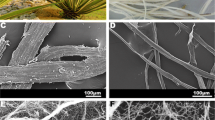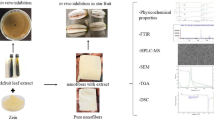Abstract
Herein, we fabricated highly porous and stretchable electrospun nanofiber membranes using eco-friendly lignin and polycaprolactone polymers, which efficiently prevent mold colonization and invasion in pine sapwood. Membranes of different thicknesses were tested against four species of mold. Membrane thicknesses of above 38 μm were found to completely prevent mold invasion during the 2- and 4-week cultivation periods. The membranes were characterized using various qualitative and quantitative analytical methods, including tensile tests. The optimized fabrication conditions were established to protect wood from mold growth and to accommodate the periodic expansion and contraction of wood without degradation. The mechanically strong and elastic nanofiber membranes enable an assessment of the membrane’s suitability and feasibility as an alternative to the existing wallpapers or paints.











Similar content being viewed by others
References
An S, Lee MW, Jo HS, Al-Deyab SS, Yoon SS (2016) Weaving nanofibers by altering counter-electrode electrostatic signals. J Aerosol Sci 95:67–72
Bernstein JA et al (2008) The health effects of nonindustrial indoor air pollution. J Allergy Clin Immunol 121:585–591
Bush RK, Portnoy JM, Saxon A, Terr AI, Wood RA (2006) The medical effects of mold exposure. J Allergy Clin Immunol 117:326–333
Chiba S et al (2009) Cladosporium species-related hypersensitivity pneumonitis in household environments. Intern Med 48:363–367
Clark N et al (2004) Damp indoor spaces and health. National Academies Press, Washington
Edmondson DA, Nordness ME, Zacharisen MC, Kurup VP, Fink JN (2005) Allergy and “toxic mold syndrome”. Ann Allergy Asthma Immunol 94:234–239
Heseltine E, Rosan J (2013) WHO guidelines for indoor air quality: dampness and mould, vol 92. WHO Regional Office for Europe, Copenhagen
Hogan CJ Jr, Niklas KJ (2004) Temperature and water content effects on the viscoelastic behavior of Tilia americana (Tiliaceae) sapwood. Trees 18:339–345
Hong JH, Lee J, Min M, Ryu SM, Lee D, Kim GH, Kim JJ (2014) 6-Pentyl-α-pyrone as an anti-sapstain compound produced by Trichoderma gamsii KUC1747 inhibits the germination of ophiostomatoid fungi. Holzforschung 68:769–774
Hu S, Hsieh Y-L (2013) Ultrafine microporous and mesoporous activated carbon fibers from alkali lignin. J Mater Chem A 1:11279–11288
Jennings DH, Lysek G (1999) Fungal biology: understanding the fungal lifestyle. Bios Scientific Publishers, Oxford
Kiffer E, Morelet M (1999) The deuteromycetes. Mitosporic fungi: classification and generic keys. Science Publishers, Enfield
Lee MW et al (2015) Polyacrylonitrile nanofibers with added zeolitic imidazolate frameworks (ZIF-7) to enhance mechanical and thermal stability. J Appl Phys 118:245307
Nelson MT, Munj HR, Tomasko DL, Lannutti JJ (2012) Carbon dioxide infusion of composite electrospun fibers for tissue engineering. J Supercrit Fluids 70:90–99
Persano L, Camposeo A, Tekmen C, Pisignano D (2013) Industrial upscaling of electrospinning and applications of polymer nanofibers: a review. Macromol Mater Eng 298(5):504–520
Pettigrew HD, Selmi CF, Teuber SS, Gershwin ME (2010) Mold and human health: separating the wheat from the chaff. Clin Rev Allergy Immunol 38:148–155
Pomés A, Chapman MD, Wünschmann S (2016) Indoor allergens and allergic respiratory disease. Curr Allergy Asthma Rep 16:1–10
Portnoy JM, Kwak K, Dowling P, VanOsdol T, Barnes C (2005) Health effects of indoor fungi. Ann Allergy Asthma Immunol 94:313–320
Redlich CA, Sparer J, Cullen MR (1997) Sick-building syndrome. Lancet 349:1013–1016
Reneker DH, Yarin AL (2008) Electrospinning jets and polymer nanofibers. Polymer 49:2387–2425
Samson RA, Hoekstra ES, Frisvad JC (2004) Introduction to food-and airborne fungi, vol 7. Centraalbureau voor Schimmelcultures (CBS), Utrecht
Schmidt O (2006) Wood and tree fungi. Springer, Heidelberg
Sett S, Lee MW, Weith M, Pourdeyhimi B, Yarin A (2015) Biodegradable and biocompatible soy protein/polymer/adhesive sticky nano-textured interfacial membranes for prevention of esca fungi invasion into pruning cuts and wounds of vines. J Mater Chem B 3:2147–2162
Singh J, Yu CWF, Kim JT (2010) Building pathology, investigation of sick buildings—toxic moulds. Indoor Built Environ 19:40–47
Stienen T, Schmidt O, Huckfeldt T (2014) Wood decay by indoor basidiomycetes at different moisture and temperature. Holzforschung 68:9–15
Viitanen H, Ritschkoff A (1991) Mould growth in pine and spruce sapwood in relation to air humidity and temperature. Swedish University of Agricultural Sciences, Uppsala
Wahba SM, Darwish AS, Shehata IH, Elhalem SSA (2015) Sugarcane bagasse lignin, and silica gel and magneto-silica as drug vehicles for development of innocuous methotrexate drug against rheumatoid arthritis disease in albino rats. Mater Sci Eng C 48:599–610
Zabel RA, Morrell JJ (2012) Wood microbiology: decay and its prevention. Academic Press, Syracuse
Zhang J, Xu J, Wang H, Jin W, Li J (2009) Synthesis of multiblock thermoplastic elastomers based on biodegradable poly (lactic acid) and polycaprolactone. Mater Sci Eng C 29:889–893
Acknowledgments
This work was primarily supported by the Industrial Strategic Technology Development Program (Grant 10045221) funded by the Ministry of Knowledge Economy (MKE, Korea). This work was also supported by the Global Frontier Hybrid Interface Materials (GFHIM) of NRF-2013M3A6B1078879, NRF-2012-Fostering Core Leaders of the Future Basic Science Program of NRF-2012H1A8003235 and the Commercializations Promotion Agency for R&D Outcomes (COMPA) funded by the Ministry of Science, ICT and Future Planning (MISP). S.S.Y. expresses his thanks to the support made by King Saud University, Vice Deanship of Research Chairs.
Author information
Authors and Affiliations
Corresponding authors
Additional information
Seongpil An and Joo-Hyun Hong have contributed equally to this work.
Electronic supplementary material
Below is the link to the electronic supplementary material.
Rights and permissions
About this article
Cite this article
An, S., Hong, J.H., Song, K.Y. et al. Prevention of mold invasion by eco-friendly lignin/polycaprolactone nanofiber membranes for amelioration of public hygiene. Cellulose 24, 951–965 (2017). https://doi.org/10.1007/s10570-016-1141-5
Received:
Accepted:
Published:
Issue Date:
DOI: https://doi.org/10.1007/s10570-016-1141-5




